2021年4月投稿
posted Aug. 2021
ご紹介する内容は、新型コロナウイルス感染症対策のため非公開の行事・名所も含みます。川上村役場「新型コロナウイルス情報」等で最新情報をご確認ください。また、ご訪問の際は、感染症防止策へのご協力をお願いいたします。
Please note that information here includes events and places unopen to public due to the Covid-19 pandemic. Visitors are recommended to check the latest information published by the Kawakami Village office.When visiting, your cooperation in following the infection prevention guidelines will be highly appreciated.
Akitsuno Ono Park
![いにしへ吉野の宮と申て。みかどのしばしばおはしまししところ。柿本ノ人まろ主の。御供にさふらひて。[万葉一]滝のみやことよみけるも。この大滝によれる所なりけんかし。そのをりをりの歌どもに。あはせて思ふに。あきづ[蜻蛉]の小野などいひしも。又滝のうへの御舟の山も。かならず此わたりなりけんこと。うたがひもなければ。今もさいふべきさましたる山やあると。心をつけて見まはすに。 いにしへ吉野の宮と申て。みかどのしばしばおはしまししところ。柿本ノ人まろ主の。御供にさふらひて。[万葉一]滝のみやことよみけるも。この大滝によれる所なりけんかし。そのをりをりの歌どもに。あはせて思ふに。あきづ[蜻蛉]の小野などいひしも。又滝のうへの御舟の山も。かならず此わたりなりけんこと。うたがひもなければ。今もさいふべきさましたる山やあると。心をつけて見まはすに。](img/episode23_title1.png)
*1
Inishieno Yoshinonomiyato moushite. Mikadono shibashiba owashimashishi tokoro. Kakinomotono Hitomaro arujino otomoni souraite. [Manyoh Ichi] Takinomiyakoto yomikerumo. Kono ohtakini yorerutokoro narikenkashi. Sono oriorino utadomoni awaseteomouni akizu[蜻蛉]no ononado iishimo. Mata takinoueno miunenoyamamo. Kanarazu korewatarinarikenkoto. Utagaimonakereba imamo saiubekisamashitaru yamayaaruto. Kokoroo tsukete mimawasuni.
Motoori Nobunaga, Sugagasa no Nikki, 1772
『菅笠日記』は、本居宣長が、明和9年(1772)3月5日から2週間、吉野・飛鳥を旅した日記です。宣長は3月9日、川上村の大滝・西河の村や、蜻蛉の滝を訪れました。
Sugagasa no Nikki is a diary that Motoori Nobunaga started on March 5, 1772. He was traveling in Yoshino and Asuka for two weeks. He visited Ohtaki and Nishikawa villages and Seireinotaki Waterfall in Kawakami on March 9.
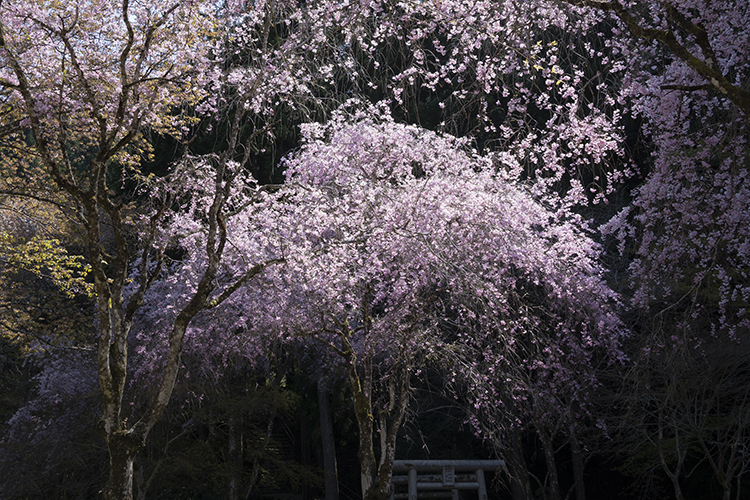

「昔、吉野の宮といって、天皇がしばしばいらっしゃったところ。柿本人麻呂もお供をして、『この川の絶ゆることなく この山のいや高しらす みなそそく 滝のみやこは 見れど飽かぬかも』(『万葉集』巻一・三六番)*2と詠んだのも、この大滝であろう。その折々の和歌をあわせて考えると、『蜻蛉の小野」』という場所も、また、滝の上の御船の山も、必ず、このあたりのことであろうと、疑いもなければ。今もそのような姿をした山はあるかと、心に留めて周囲を見回すと。」と、奈良時代に柿本人麻呂が讃美した滝の都に、宣長が思いを馳せていることが記されます。
‘There used to be Yoshino no Miya, Yoshino Palace, in this area. The emperor came and stayed from time to time. On one of such occasions Kakinomoto Hitomaro accompanied the emperor to Ohtaki and wrote this waka: konokawano tayurukotonaku konoyamano iyatakashirasu minasosoku takinomiyakowa miredo akanukamo (Manyohshu, No.1, 36). On this day I look around to find a mountain that fits the description as I firmly believe Hitomaro’s Seireino Ono and Mt. Mihune are about here.’
吉野宮や、柿本人麻呂が「滝のみやこ」と詠んだ場所は、現在、吉野町・宮滝遺跡に比定されていますが、本居宣長は、川上村訪問時に吉野宮を想起したようです。この記述の直後に「西河のかたへかへり。(略)せいめいが滝を見る。これはかの大滝とはやうかはりて」とあり、川上村の地名が続きます。残念ながら、『菅笠日記』に川上村の桜の様子は書き残されていませんが、宣長の目に、春の「滝のみやこ」はどのように映ったのでしょうか。
Motoori Nobunaga continued to write ‘Nishikawano katae kaeri…Seimeigatakio miru. Korewa kano ohtakito wakarite ’. Today both Yoshino Palace and Hitomaro’s takinomiyako are now identified as parts of Yoshino Miyataki Ruin. It is disappointing but the association Motoori made between Yoshino Palace and Kawakami Village is believed to be not quite correct.
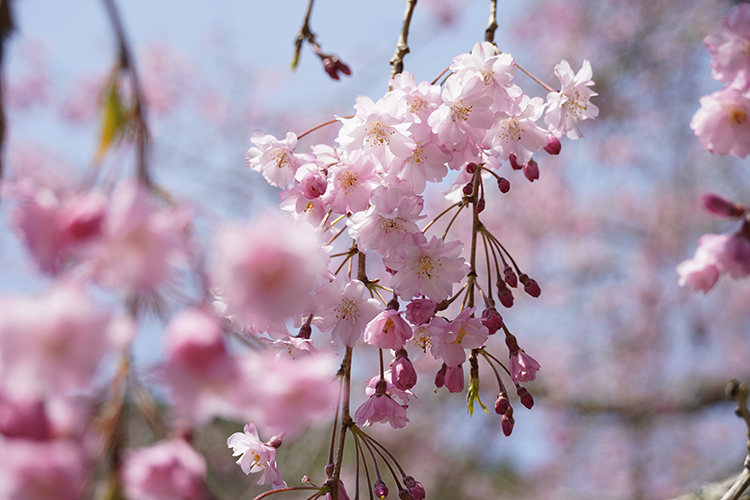

It is also disappointing that there is no mention of Kawakami’s gorgeous cherry blossoms in Sugagasa no Nikki. It is not difficult to imagine that the author would have been impressed by its cherry blossoms had he been in ‘takinomiyako’ Kawakami in spring.
Seireinotaki Waterfall

*3
Horohoroto yamabuki chiruka takino oto
Matsuo Basho, Oino Kobumi, Edo Period
『貞享5年(1688)3月下旬、松尾芭蕉(1644~1694)は吉野を訪れました。『笈の小文』によると、3月19日に故郷の伊賀上野を出発し、初瀬(長谷寺)、多武峰、龍門と歩みを進めています。この句の前書には「西河」とあり、川上村西河にて詠まれたことが分かります。
Matsuo Basho (1644-1694) visited Yoshino late March in 1688 (Jyokyo 5). He left his hometown Iga-Ueno on March 19, then visited Hase (the Hase-dera temple), Tohnomine, and Ryumon according to Oino Kobumi. He probably composed the haiku in Nishikawa, Kawakami Village.
句の大意は、「滝の音が大きく響く中、その滝のほとりに咲く山吹の黄色い花が、ほろほろと散っているよ」。晩春、暖かく差し込む日の光の中で、鮮やかな黄色の山吹の花が咲き誇っていたことでしょう。一方で、大きく響く滝の音。静と動の対比が見事な一句です。
Imagine a scene in late spring when the air was filled with rays of warm sunlight, the bright yellow blossom of yamabuki welcomed Basho, while in the background the waterfall was running forcefully and its sound echoing loud. You will notice and appreciate the great contrast between stillness and motion the haiku managed to emphasize.
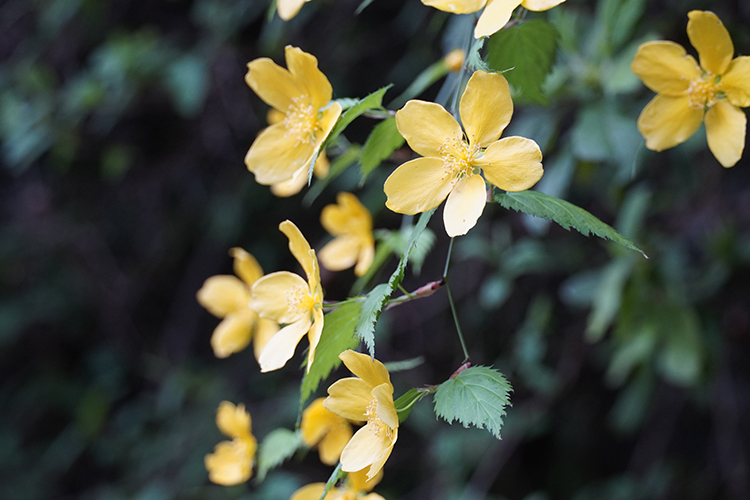

Niu-Kawakami Jinjya Kamisha
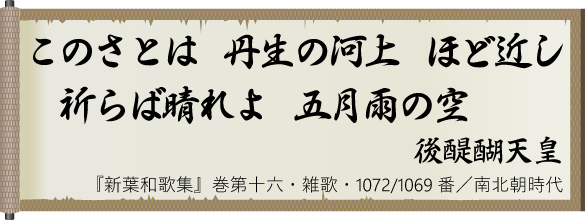
*4
Konosatowa Niuno kawakami hodochikashi inorabahareyo samidarenosora
Emperor Godaigo, Shin'yohwakashu, vol.16, zouka no.1072/1069, Nambokucho Period
ー現代語訳ー
この里は、水の神様がいらっしゃる丹生川上にほど近い。この祈りが届いたならば晴れてほしい、五月雨の空よ。
Meaning
This village is close to Niu-Kawakami. If you hear this prayer, O Water God, please clear the sky for us. Please stop the samidare (early summer rains) for us.
詞書には、次のように記されています。「芳野の行宮にて五月雨はれまなかりける比、雨師の社へ止雨の奉幣使などたてられける時、おぼしめしつづけさせ給ける」。後醍醐天皇が吉野行宮にいらっしゃる頃、すなわち延元元年(北朝建武三年・1336)12月末から延元四年(北朝暦応二年・1339)にかけてのことです。五月雨によって晴れ間が見えない日が続きました。後醍醐天皇は雨師の社、すなわち、雨を司る神様に雨を止めることを祈って奉幣使を派遣します。その際に詠まれた和歌です。
A commentary (kotobagaki) for this waka states: Yoshinono anguunite samidare haremanakarikeru koro amashino yashiroe shiuno houheishi nado taterarekerutoki oboshimeshi tsuzukesasetamaikeru. Emperor Godaigo was staying in a temporary royal accommodation in Yoshino from the end of December 1336 to 1339 (from the first year to the fourth year of Engen). One year the Samidare rainfall did not stop and there was no sunshine for days. Emperor Godaigo despatched a Hoheishi (priest) to Niu-Kawakami Shrine hoping to stop the rain with his help. The waka was composed on this occasion.
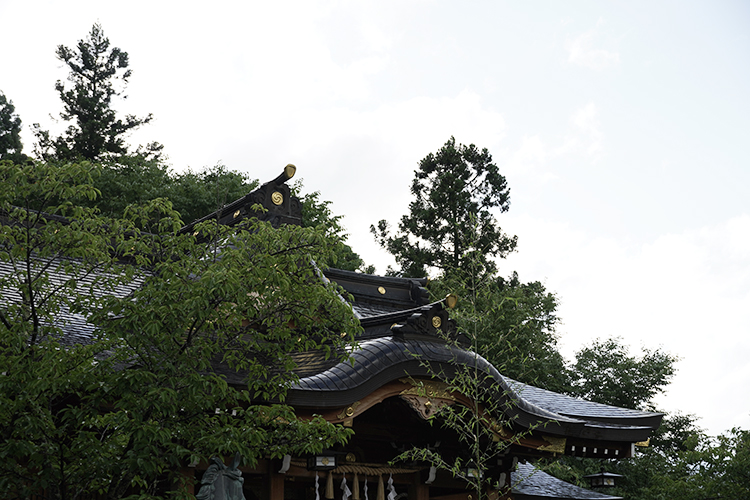

丹生川上神社上社は、今も「水の神様」として信仰を集めています。古来より、脈々と受け継がれてきた祈りの深さを実感せずにいられません。
Niu-Kawakami Jinjya Kamisha even nowadays is the shrine for prayers to Water God. The prayers have been repeated by so many people since then for years and years.
*1 : 『菅笠日記』本文は、奈良女子大学学術情報センター蔵『菅笠日記』本文に依る。ただし、私に表記を改めた箇所がある。なお、奈良女子大学学術情報センター「所蔵資料電子画像集・江戸時代紀行文集」には、『菅笠日記』の行程表・行程図も掲載されている。
*2 : 古典本文は『新編日本古典文学全集 万葉集(1)』(小学館)に拠る。ただし、私に表記を改めた箇所がある。なお、柿本人麻呂和歌の詳細は「そらみつ文庫」第8話参照。
*3 : 古典本文は、『新編日本古典文学全集 松尾芭蕉集(2)』に拠る。ただし、私に表記を改めた箇所がある。本句の詳細は、「そらみつ文庫」第5話参照。
*4 : 和歌本文および詞書は『新編国歌大観』DVD-ROMに拠る。ただし、表記を私に改めた箇所がある。なお、本歌の詳細は、「そらみつ文庫」第3話参照。

